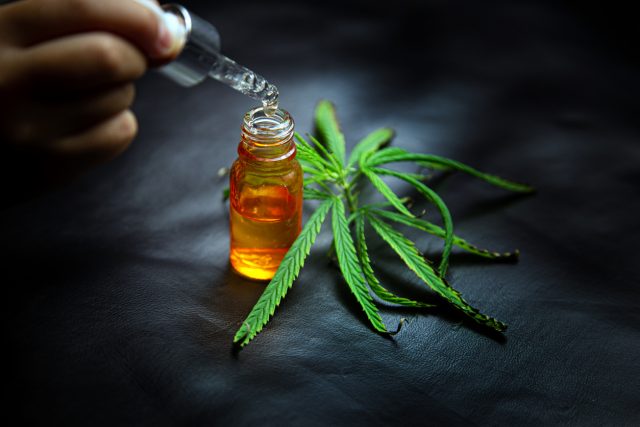This particular Research Review will use a variety of studies and study reviews to summarise answers for the following questions about Cannabidiol (CBD).
- What is CBD?

- How does it work for chronic pain and arthritis?
- Is CBD better than common mainstream pain medications (e.g., NSAIDs, Opioids)?
- Are there any side effects of CBD?
- Are there any guidelines/recommendations?
- Can I get CBD over the counter (OTC)?
Please be aware that Arthritis NSW is not providing clinical advice on the individual use of CBD products. The purpose of presenting this information is to provide an objective and non-biased review of the literature. The information presented is for education purposes only.
What is Cannabidiol (CBD)?
- The Cannabis sativa plant contains 144 components known as cannabinoids, which are drugs that act on the endocannabinoid system in the brain. The endocannabinoid system in the brain is not a structure per se, but a molecular system responsible for regulating and balancing many processes in the body, including immune response, communication between cells, appetite and metabolism, memory and anxiety/mood. Endocannabinoids are essentially neurotransmitters that bind to cannabinoid receptors that are active in the central nervous system (CNS; brain and spine) and peripheral nervous system.
- Of the 144 cannabinoids, two are of medical interest – the psychoactive delta-9-tetrahydrocannabinol (THC) and the non-psychoactive component Cannabidiol (CBD). When in the body, CBD and THC interact with cannabinoid receptors to help treat or limit the effects of various conditions.
- Medical marijuana* contains cannabis or cannabinoids that have a THC concentration greater than 0.3%. THC is the euphoria-producing, hallucinogenic component of marijuana.
- On the other hand, CBD products that are extracted from hemp** contain less than 0.3% THC and can come in many forms, including oils, sprays and food, among many other options. Since these CBD products do not contain greater than 0.3% THC, they do not require a prescription like typical medical marijuana, and the products in them are not regulated and sometimes do not contain the same ingredients as marketed. CBD is not addictive and carries with it very little risk in its use.
How does it work?
- The mechanism behind how CBD works is complex and still under investigation.
- The most well-known proposed mechanism for CBD is its effect on type 1 cannabinoid receptors (CB1) and type 2 cannabinoid receptors (CB2). CB1 receptors are mainly located in the CNS, particularly in regions of the midbrain and spinal cord that are responsible for pain perception, therefore can help to reduce pain severity and chronic pain.
- CB2 receptors are more often associated with the immune system. In a rather complex way, they can inhibit the inflammatory response. Because of this, CBD helps reduce pain and inflammation, and in turn may help to reduce disease progression, such as those with inflammatory arthritis and OA.
- Essentially, the mechanism/s by which CBD works is still unclear, nonetheless, research indicates CBD has been attributed to analgesic, anti-oxidative, anti-inflammatory, anti-convulsant, and anxiolytic properties.
- There have been many studies using animal models. The first thing you must know is, while there are promising results on the efficacy of CBD use in chronic pain and arthritis in animal models, they cannot be generalised to the human population. However, if there are promising results in animal models, then trials are progressed to using humans. Since animal studies have shown such promising results for the efficacy of CBD, clinical trials have been conducted on humans for a few years now. For example, one of the earliest studies by Blake et al. (2006) studied the efficacy, tolerability and safety of the cannabis-based medicine (CBM) called, Sativex. Sativex (aka Nabiximols) is used to treat RA, neuropathic pain and multiple sclerosis. In this first ever controlled trial of a CBM in rheumatoid arthritis, the study saw a significant analgesic effect and even indications that disease activity was significantly suppressed following the use of Sativex. Other published scientific inquiries have found similar connections between overall cannabis use and the reduction of chronic pain.
Is CBD better than common mainstream pain/arthritis medications (e.g., NSAIDs, Opioids)?
- While further studies are to be conducted, many studies comparing CBD with other typical pain medications tend to CBD superior. For example, Capano et al. (2019) found over half of the chronic pain patients (53%) in the study reduced or eliminated their opioid use within eight weeks after adding CBD-rich hemp extract to their regimens. Therefore, it is suggested that CBD could significantly reduce opioid use and improve chronic pain and sleep quality among patients who are currently using opioids for pain management.
- When comparing side effects, CBD appears to have fewer or less severe side effects than mainstream pain medications.
- The medications used to treat arthritis include disease-modifying anti-rheumatic drugs (DMARDs), biologic response modifiers, corticosteroids and more. By far, though, most arthritis suffers typically rely on painkillers—either acetaminophen/paracetamol, nonsteroidal anti-inflammatory drugs (NSAIDs) or prescribed opioids.
- While effective (for the short term anyway), NSAIDS, corticosteroids and opioids only mask pain and their side effects carry substantial health risks and side effects, especially for the older populations.
- CBD is presenting as a safe and potentially effective medical alternative to more risky medications commonly prescribed for arthritis pain. Cannabidiol use has little to no health risk or adverse side effects like those presented by NSAIDs and opioid medications. Though, research into CBD use and efficacy have only begun and more longitudinal studies need to be conducted in order to assess the side effects and efficacy of CBD use.
Are there any side effects of CBD?
- Yes there are. In a systematic review by Darkovska-Serafimovka et al. (2018), 15 of 18 trials demonstrated a significant analgesic effect on CBD as compared to placebo. Patients reported over 30% reduction in pain intensity. The main side effects reported were drowsiness, nausea, vomiting, and dry mouth, however they were generally well tolerated, mild to moderate.
- Side effects may be dose dependent, and dependent on other ingredients included in CBD products.
Are there any guidelines/recommendations?
- Do your research. Health consumers should turn to products that have undergone some form of independent validation testing to ensure that the CBD they use is safe and is made from trusted and advertised ingredients. Not all CBD products provide the ingredients and effects of what the labels might promise.
- People taking CBD should do so for several weeks to better determine its effect on their health. Like many other medications or supplements, it is simply unrealistic for consumers to use CBD once or twice and expect consistent beneficial outcomes, which often don’t manifest until a week or more after CBD use begins.
- Also, CBD users should experiment with the different forms of CBD treatments to find the one with the greatest efficacy for their individual needs. For example, many arthritis sufferers might find that topical (transdermal) CBD products provide the best relief, while other individual arthritis suffers might get their best results from oral or sublingual forms of CBD instead. Regardless of the form used, CBD generally offers an attractive alternative to other medications, especially those with high health risks and substantial side effects like those exhibited in NSAID and opioid therapies.
6. Can I get CBD over the counter (OTC)?
- Yes you can, however, medicalised cannabis or CBD in Australia is a schedule 4 drug, which means you need a prescription for it.
- Just recently, the schedule of low dose CBD has been down-scheduled to a schedule 3. This means, you can now get certain low dose CBD products OTC without a script.
- But wait! Before you run off to your local pharmacy, while the class schedule been dropped, there are currently no TGA approved products on the Australian Register of Therapeutic Goods (ARTG) that meet the Schedule 3 criteria…Yet! Please check out this website for further information regarding this. https://www.tga.gov.au/media-release/over-counter-access-low-dose-cannabidiol
Schedule 3 cannabidiol (CBD) cannot be supplied under the Special Access Scheme (SAS) and must be included (registered) on the Australian Register of Therapeutic Goods (ARTG).
There are also limitations for low-dose CBD products, namely:
- the maximum dose is limited to 150 mg per day
- products must be contained child-resistant packaging
- product forms are limited to oral, oral mucosal, and sublingual formulations only (i.e. no vaping, no topicals)
Please refer below for research references.
Author: Kat Keane, Health Educator ANSW
Published: 16/2/2021
Last updated: 16/2/2021
Arthritis NSW – we’re here to help
We’re here to help whenever you need us. We have a variety of options available for support and information.
- For more BLOG articles about managing your arthritis, please visit our News page here.
- Sign up to eNews to get information and advice on managing your condition
- Call our free helpline on 1800 011 041 (Monday to Friday, 9am to 5pm)
- We are a health charity, help us to deliver our services – donate here
- Join our online community: Follow us on Facebook or Instagram
- Subscribe to our magazine, more info here
- Become a member, more info here
References
Blake DR, Robson P, Ho M, Jubb RW, McCabe CS. Preliminary assessment of the efficacy, tolerability and safety of a cannabis-based medicine (Sativex) in the treatment of pain caused by rheum
Capano A, Weaver R, Burkman E. Evaluation of the effects of CBD hemp extract on opioid use and quality of life indicators in chronic pain patients: a prospective cohort study. Postgrad Med. 2020 Jan;132(1):56-61. doi: 10.1080/00325481.2019.1685298.
Darkovska-Serafimovska M, Serafimovska T, Arsova-Sarafinovska Z, Stefanoski S, Keskovski Z, Balkanov T. Pharmacotherapeutic considerations for use of cannabinoids to relieve pain in patients with malignant diseases. J Pain Res. 2018;11:837–42.
Gusho, C. A., & Court, T. (2020). Cannabidiol: A Brief Review of Its Therapeutic and Pharmacologic Efficacy in the Management of Joint Disease. Cureus, 12(3), e7375. https://doi.org/10.7759/cureus.7375
Khaleghi, M. (2020). New Arthritis Foundation Guidelines On CBD Use Could Be First of Many More to Come. Alternative therapies in health and medicine, 26, 8-11.
Urits, I., Gress, K., Charipova, K., Habib, K., Lee, D., Lee, C., … & Viswanath, O. (2020). Use of cannabidiol (CBD) for the treatment of chronic pain. Best Practice & Research Clinical Anaesthesiology.
